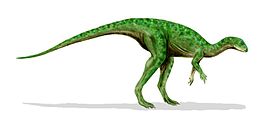
Back Hypsilophodontidae AF هيبسيلوفودونتيات Arabic Hipsilofodòntids Catalan Hypsilophodontidae Czech Hypsilophodontidae German Hypsilophodontidae English Hipsilofodontedoj EO Hypsilophodontidae Spanish بلندتاجدندانان FA Hypsilophodontidae French
| Hypsilophodontidae | ||||||||||||||||||
|---|---|---|---|---|---|---|---|---|---|---|---|---|---|---|---|---|---|---|
| Evolúciós időszak: középső jura-késő kréta, 165–65,5 Ma | ||||||||||||||||||
 Az Othnielosaurus rekonstrukciója
| ||||||||||||||||||
| Természetvédelmi státusz | ||||||||||||||||||
| Fosszilis | ||||||||||||||||||
| Rendszertani besorolás | ||||||||||||||||||
| ||||||||||||||||||
| Nemek | ||||||||||||||||||
|
Lásd a szövegben. | ||||||||||||||||||
| Hivatkozások | ||||||||||||||||||
A Wikifajok tartalmaz Hypsilophodontidae témájú rendszertani információt. A Wikimédia Commons tartalmaz Hypsilophodontidae témájú kategóriát. |
A Hypsilophodontidae (melynek neve az iguana gyíkok közé tartozó Hypsilophusra, azaz, a 'magas taréjú fogra' utal) a kisméretű ornithopoda dinoszauruszok egyik családja, melybe két lábon járó, gyors mozgású, 1–2 méter hosszú növényevők tartoznak. A maradványaik Ázsia, Ausztrália Európa, Észak-Amerika és Dél-Amerika középső jura–késő kréta kori kőzeteiből egyaránt ismertté váltak. A hagyomány szerint nem csak az iguanodontiák, hanem majdnem minden két lábon járó madármedencéjű ebbe a családba tartozik, ami egyes filogenetikus elemzések szerint természetes csoportot alkot,[1][2] bár az újabb keletű tanulmányok szerint többnyire parafiletikus, a benne levő taxonok pedig egy olyan sorozatot képviselnek, ami az Iguanodontia kládhoz vezet.[3][4][5][6][7][8][9] E tanulmányok egy része több tradicionális hypsilophodontidát is eltávolított az Ornithopoda alrendágból.[10][11] Emiatt a csoport egyetlen biztos tagja a Hypsilophodon. A dinoszauruszok családfájának e területét bonyolítja a kutatások hiánya.
- ↑ Sues, Hans-Dieter, and Norman, David B..szerk.: Weishampel, David B.; Dodson, Peter; and Osmólska, Halszka (eds.): Hypsilophodontidae, Tenontosaurus, Dryosauridae, The Dinosauria, 1st, Berkeley: University of California Press, 498–509. o. (1990). ISBN 0-520-06727-4
- ↑ Weishampel, David B., and Heinrich, Ronald E. (1992). „Systematics of Hypsilophodontidae and Basal Iguanodontia (Dinosauria: Ornithopoda)”. Historical Biology 6, 159–184. o. [2007. szeptember 30-i dátummal az eredetiből archiválva]. DOI:10.1080/10292389209380426. (Hozzáférés: 2007. március 10.)
- ↑ Scheetz, Rodney D. (1998). „Phylogeny of basal ornithopod dinosaurs and the dissolution of the Hypsilophodontidae”. Journal of Vertebrate Paleontology 18 (3, Suppl.), 75A. o.
- ↑ Winkler, Dale A., Murry, Phillip A.; and Jacobs, Louis L. (1998). „The new ornithopod dinosaur from Proctor Lake, Texas, and the deconstruction of the family Hypsilophodontidae”. Journal of Vertebrate Paleontology 18 (3, Suppl.), 87A. o.
- ↑ Buchholz, Peter W.. Phylogeny and biogeography of basal Ornithischia, The Mesozoic in Wyoming, Tate 2002. Casper, Wyoming: The Geological Museum, Casper College, 18–34. o. (2002)
- ↑ Weishampel, David B., Jianu, Coralia-Maria; Csiki, Z.; and Norman, David B. (2003). „Osteology and phylogeny of Zalmoxes (n.g.), an unusual euornithopod dinosaur from the latest Cretaceous of Romania”. Journal of Systematic Palaeontology 1 (2), 1–56. o. DOI:10.1017/S1477201903001032.
- ↑ Norman, David B., Sues, Hans-Dieter; Witmer, Larry M.; and Coria, Rodolfo A..szerk.: Weishampel, David B.; Dodson, Peter; and Osmólska, Halszka (eds.): Basal Ornithopoda, The Dinosauria, 2nd, Berkeley: University of California Press, 393–412. o. (2004). ISBN 0-520-24209-2
- ↑ Varricchio, David J., Martin, Anthony J.; and Katsura, Yoshihiro (2007). „First trace and body fossil evidence of a burrowing, denning dinosaur”. Proceedings of the Royal Society B: Biological Sciences 274 (1616), 1361–1368. o. DOI:10.1098/rspb.2006.0443. PMID 17374596. PMC 2176205. (Hozzáférés: 2007. március 22.)
- ↑ Boyd, Clint A., Brown, Caleb M.; Scheetz, Rodney D.; and Clarke, Julia A. (2009). „Taxonomic revision of the basal neornithischian taxa Thescelosaurus and Bugenasaura”. Journal of Vertebrate Paleontology 29 (3), 758–770. o. DOI:10.1671/039.029.0328.
- ↑ Butler, Richard J., Smith, Roger M.H.; and Norman, David B. (2007). „A primitive ornithischian dinosaur from the Late Triassic of South Africa, and the early evolution and diversification of Ornithischia”. Proceedings of the Royal Society B: Biological Sciences 274 (1621), 2041. o. DOI:10.1098/rspb.2007.0367. PMID 17567562. PMC 2275175.
- ↑ Butler, Richard J., Upchurch, Paul; and Norman, David B. (2008). „The phylogeny of the ornithischian dinosaurs”. Journal of Systematic Palaeontology 6 (1), 1–40. o. DOI:10.1017/S1477201907002271.

